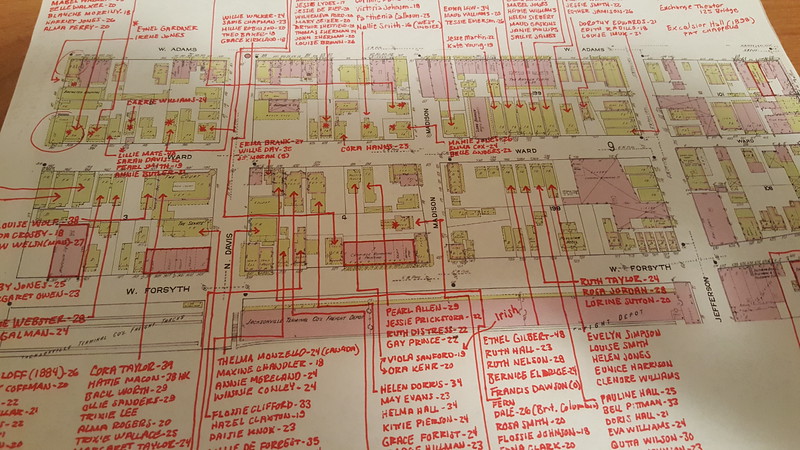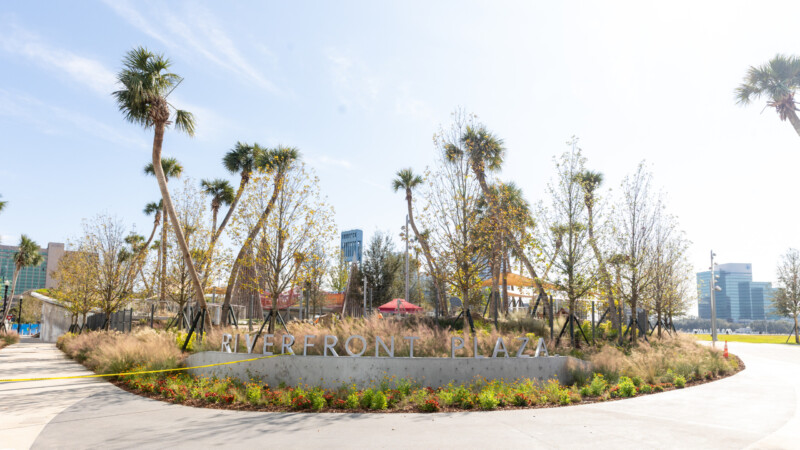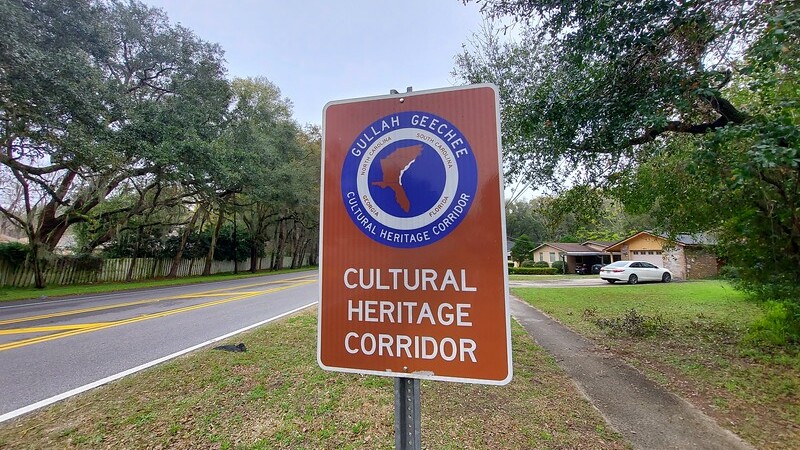
Now known as Houston Street in the LaVilla neighborhood, Ward Street was once the epicenter of one of the South’s largest bustling red light districts. Originating in the late 1880s, Jacksonville’s notorious red light district was called “The Line” and offered nearly 60 bordellos on a four-block stretch of the street between Lee and Broad streets. Since the district was shut down during the 1950s, little has been mentioned of the women associated with it. In honor of Women’s History Month, here is a look into the lives of The Line’s well-known madams.
Cora Crane

The Court, the most celebrated red light district establishment, was operated by Cora Crane. Crane was the common law widow of esteemed author Stephen Crane. The Court was located one block east of the house where James Weldon and John Rosamond Johnson were born. It was a two-story brick building with 14 bedrooms, a ballroom, kitchens, a dining room and an annex with eight more bedrooms. Born into a relatively elite New York family in 1865 as Cora Ethel Eaton Howarth, Crane traveled extensively for her time and lived in a variety of locations across the world, including Boston, San Francisco, New York City, and Europe. She was known to pay for the burials of prostitutes who took their own lives.
She also served as a war correspondent during the Greco-Turkish War in Greece when she traveled there with Stephen Crane and is recognized as one of the earliest female war correspondents. She was also a contributor to magazines such as Smart Set and Harper’s Weekly, including during the time she was running her bordellos in Jacksonville and Pablo Beach (now Jacksonville Beach). Her obituary acknowledged both her role as proprietress of The Court and the fact that she was a “well-known writer of short stories,” stating “[s]he was a brilliant woman and she had a light, snappy diction in her writing that classed her among the leading writers of the profession. Her works were read by thousands of appreciative readers.”
Lyda De Camp
-X2.jpg)
Lyda (or Lydia) De Camp was born in May 1869 in Kentucky. In February 1897, she caught the attention of noted author Stephen Crane, who inscribed a copy of his book Maggie “To Lyda.” In 1900, she rented a brothel at 949 Ward (now Houston) St. in Jacksonville. Here, she managed a woman named Thelma Earle who was born in Sweden in November 1868. In 1903, she had a large brothel built further east at the northeast corner of Ward and Madison streets. This two-story frame house had a bay window and porch facing Ward Street. While her brothel was not as elegant as her competitor Cora Crane’s The Court, it was well known to newspapermen frequenting the district. Women managed by De Camp in 1910 included Ada Fuller from Illinois, Virginia Earl from Virginia, June Darlington from Oklahoma, Margaret Cooper from Pennsylvania, Marion Morris from North Carolina, and Billie Lyon from Ohio.
Belle Orloff
-L.jpg)
Known as the Russian Belle, Belle Orloff was born in Florida in 1884. She shows up in the 1896 city directory as the madam of The Club, a bordello that was then located at 717 Ward St. After the Great Fire of 1901, she relocated two blocks west to 966 Ward St.
During a visit to The Line in 1908, Temperance crusader Carry A. Nation had been cordially received at the New York Inn. However, at Orloff’s establishment, the two had a very heated argument, leading Nation to declare Jacksonville to be a “demonocracy.”
Taking a liking to a young Charlie Wall after he was kicked out of a local school for spending the night in her brothel, Orloff taught him the tricks of her trade. While he had a head for numbers, she played an instrumental role in Wall’s eventual rise as Tampa’s mafia boss during the early 20th century.
Rosa Neunert

During the mid-1890s, Rosa Neunert purchased five parcels of property on Ward Street between Davis and Madison streets, where she developed three houses of prostitution, the Turkish Harlem in 1897, the New York Inn in 1901 and 836 Houston Street in 1904.
During the 1920s, her properties were described as elaborate and well kept buildings with elegant interiors with wallpaper, oriental rugs, fine draperies and antique furnishings, and they catered to the socially elite. Each had a similar floor plan, with parlors or “ballrooms” in the front followed by a central hall providing access to a number of bedrooms on either side.
Although Rosa Neunert wasn’t personally a prostitute or madam, she was known to show up at an appointed time and day once a month to collect her rent. In cash. In 1913, the agents for the nearby Flagler Hotel accused Neunert and her madams of knowingly consenting to the commission of acts of prostitution. She sold her last property in 1963 and then lived off the income until her death at the age of 99 in 1968. She then left her sizable estate to the Church of Jesus Christ of Latter Day Saints.
Hazel Harris

Completed in 1897 for Rosa Neunert at 832 Ward St., the Turkish Harlem was known as a brothel serving Jacksonville’s socially elite. Born in Illinois in 1879, Hazal Harris rented the property from Neunert in 1910. Madame Harris managed Dick Ward, Alice Smith, Bolley Sears, Evelyn Burroughs and Edna Edwards, all women between 21 and 25 from Florida or Georgia.
Fern Dale
-L.jpg)
Not all women who owned, managed or worked in the red light district’s bordellos were from the U.S. For a period of time, Fern Dale rented 836 Ward St. from Rosa Neunert. Dale was born in British Columbia, Canada, in 1884. How she arrived in Jacksonville is unknown. However, in 1910 and 1911, she operated a small brothel out of Neunert’s property, where she managed Edna Clark, Rosa Smith and Flossie Johnson. At the time, all were under the age of 21. In 1912, Dale relocated her business a few blocks west to a larger two-story property at the northwest corner of Ward and Jefferson streets.
Mabel Walker
-X2.jpg)
Born in Georgia in 1877, Mabel Walker was an African American madam who operated a brothel at 949 Ward St. Her brothel and an adjacent saloon were located directly across the street from the childhood residence of James Weldon and John Rosamond Johnson.
Life on The Line was largely segregated. By the second decade of the 20th century, the majority of bordellos located on the north side of Ward Street were operated by African American women. According to the 1910 U.S. Census, Walker’s establishment was home to sex workers Harriett Jones, Alma Perry, Belle Walker, and Blanche Morriisy. At the time, all of the women employed there had come to Jacksonville from South Carolina and Georgia and ranged in age from 18 to 26. Walker’s property was attached to a saloon owned by an African American man named George Stevens. Born in 1869 in Georgia, Stevens lived with James Govan at 801 W. Forsyth St., and the two operated a saloon called James & Stevens. Today, 801 W. Forsyth St. is one of the last remaining buildings that is historically associated with the red light district.







